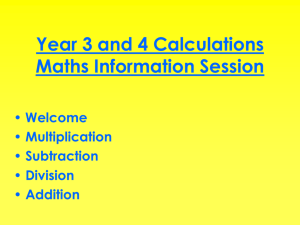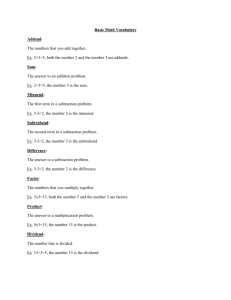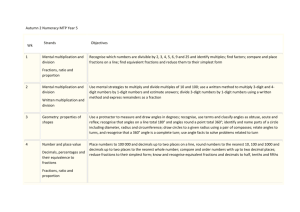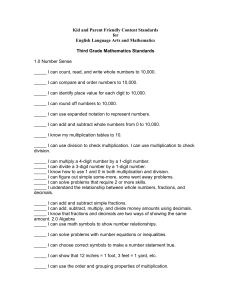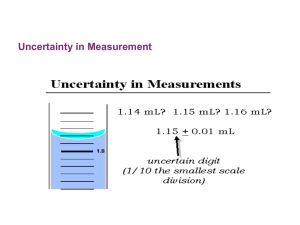Year 5 Calculation Policy - Chester Blue Coat CE Primary School
advertisement
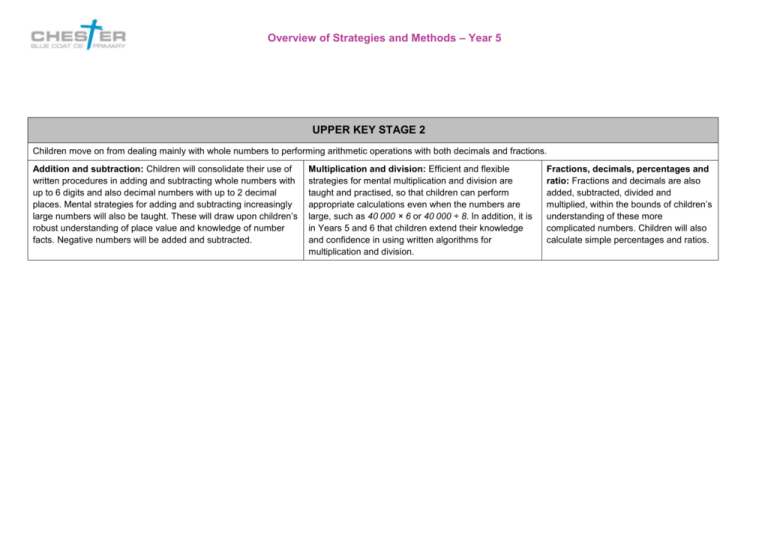
Overview of Strategies and Methods – Year 5 UPPER KEY STAGE 2 Children move on from dealing mainly with whole numbers to performing arithmetic operations with both decimals and fractions. Addition and subtraction: Children will consolidate their use of written procedures in adding and subtracting whole numbers with up to 6 digits and also decimal numbers with up to 2 decimal places. Mental strategies for adding and subtracting increasingly large numbers will also be taught. These will draw upon children’s robust understanding of place value and knowledge of number facts. Negative numbers will be added and subtracted. Multiplication and division: Efficient and flexible strategies for mental multiplication and division are taught and practised, so that children can perform appropriate calculations even when the numbers are large, such as 40 000 × 6 or 40 000 ÷ 8. In addition, it is in Years 5 and 6 that children extend their knowledge and confidence in using written algorithms for multiplication and division. Fractions, decimals, percentages and ratio: Fractions and decimals are also added, subtracted, divided and multiplied, within the bounds of children’s understanding of these more complicated numbers. Children will also calculate simple percentages and ratios. Overview of Strategies and Methods – Year 5 Year 5 Mental Methods Using place value Addition Count in 0·1s, 0·01s e.g. Know what 0·1 more than 0·51 is Partitioning e.g. 2·4 + 5·8 as 2 + 5 and 0·4 + 0·8 and combine the totals: 7 + 1·2 = 8·2 Year 5 Written Methods Expanded column addition for money leading to compact column addition for adding several amounts of money e.g. £14·64 + £28·78 + £12·26 N.B. It is essential that children use £ OR p – not both. Compact column addition to add pairs of 5-digit numbers Continue to use column addition to add towers of several larger numbers Use compact addition to add decimal numbers with up to 2 decimal places N.B. Digits carried go ABOVE not below the line. e.g. 15·68 + 27·86 Add related fractions e.g. 3/4 + 1/8 = 7/8 Overview of Strategies and Methods – Year 5 Year 5 Mental Methods Year 5 Written Methods Counting on Addition Add two decimal numbers by adding the 1s, then the 0·1s/0·01s e.g. 5·72 + 3·05 as 5·72 + 3 (8·72) + 0·05 = 8·77 Add near multiples of 1 e.g. 6·34 + 0·99 e.g. 5·63 + 0·9 Count on from large numbers e.g. 6834 + 3005 as 9834 + 5 Using number facts Number bonds to 1 and to the next whole number e.g. 5·7 + 0·3 e.g. 0·4 + 0·6 . . 0 Add to the next 10 from a decimal number e.g. 7·8 + 2·2 = 10 1 Overview of Strategies and Methods – Year 5 Year 5 Mental Methods Taking away Subtraction Use place value to subtract decimals e.g. 4·58 – 0·08 e.g. 6·26 – 0·2 Take away multiples of powers of 10 e.g. 15 672 – 300 e.g. 4·82 – 2 e.g. 2·71 – 0·5 e.g. 4·68 – 0·02 Partitioning or counting back e.g. 3964 – 1051 e.g. 5·72 – 2·01 Subtract near multiples of 1, 10, 100, 1000, 10 000 or £1 e.g. 86 456 – 9999 e.g. 3·58 – 1·99 Year 5 Written Methods Compact column subtraction for numbers with up to 5 digits e.g. 16 324 – 8516 Continue to use counting up subtraction for subtractions involving money, including finding change e.g. £50 − £28·76 4p £20 £1 20p £29 £30 Use counting up subtraction to subtract decimal numbers Counting up Find a difference between two numbers by counting up from the smaller to the larger e.g. £12·05 − £9·59 e.g. 2009 – 869 e.g. 4·2 – 1·74 Subtract related fractions e.g. 3/4 – 1/8 = 5/8 NB Counting up subtraction provides a default method for ALL children Overview of Strategies and Methods – Year 5 Year 5 Mental Methods Subtraction Find change using shopkeepers’ addition e.g. Buy a toy for £6·89 using £10·00 Find a difference between two amounts of money by counting up Using number facts Derived facts from number bonds to 10 and 100 e.g. 2 – 0·45 using 45 + 55 = 100 e.g. 3 – 0·86 using 86 + 14 = 100 Number bonds to £1, £10 and £100 e.g. £4·00 – £3·86 e.g. £100 – £66 using 66 + 34 = 100 Year 5 Mental Methods Overview of Strategies and Methods – Year 5 Year 5 Mental Methods Doubling and halving Double amounts of money using partitioning e.g. double £6·73 Multiplication Use doubling and halving as a strategy in multiplying by 2, 4, 8, 5 and 20 e.g. 58 × 5 is half of 58 × 10 (580) = 290 Grouping Multiply whole numbers and decimals by 10, 100, 1000 e.g. 3·4 × 100 = 340 Use partitioning to multiply ‘friendly’ 2- and 3-digit numbers by 1-digit numbers e.g. 402 × 6 as 400 × 6 (2400) and 2 × 6 (12) = 2412 ×6 ×6 Use partitioning to multiply decimal numbers by 1-digit numbers e.g. 4·5 × 3 as 4 × 3 (12) and 0·5 × 3 (1·5) = 13·5 Multiply near multiples by rounding e.g. 32 × 29 as (32 × 30) – 32 = 928 Year 5 Written Methods Short multiplication of 2-, 3- and 4-digit numbers by 1-digit numbers e.g. 435 × 8 Long multiplication of 2-, 3-and 4-digit numbers by ‘teen’ numbers e.g. 48 × 16 Overview of Strategies and Methods – Year 5 Year 5 Mental Methods Multiplication Using number facts Use times-tables facts up to 12 × 12 to multiply multiples of 10/100 of the multiplier e.g. 4 × 6 = 24 so 40 × 6 = 240 and 400 × 6 = 2400 Use knowledge of factors and multiples in multiplication e.g. 43 × 6 is double 43 × 3 e.g. 28 × 50 is half of 28 × 100 (2800) = 1400 Know square numbers and cube numbers Year 5 Written Methods Grid multiplication of numbers with up to 2 decimal places by 1digit numbers e.g. 1·34 × 6 Multiply fractions by 1-digit numbers e.g. 3/4 × 6 = 18/4 = 4 2/4 = 4 1/2 NB Grid multiplication provides a default method for ALL children Overview of Strategies and Methods – Year 5 Year 5 Mental Methods Doubling and halving Halve amounts of money using partitioning e.g. half of £14·84 is half of £14 (£7) plus half of 84p (42p) Year 5 Written Methods Use a written version of a mental strategy to divide 3-digit numbers by 1-digit numbers e.g. 186 ÷ 6 as 30 x 6 (180) and 1 x 6 (6) Brainstorm first, e.g. 1 x 6 = 6, 2 x 6 = 12, etc Use doubling and halving as a strategy in dividing by 2, 4, 8, 5 and 20 e.g. 115 ÷ 5 as double 115 (230) ÷ 10 = 23 Division e.g. 326 ÷ 6 as 50 × 6 (300) and 4 × 6 (24), remainder 2 Grouping Divide numbers by 10, 100, 1000 to obtain decimal answers with up to 3 decimal places e.g. 340 ÷ 100 = 3·4 Using number facts Use division facts from the times-tables up to 12 × 12 to divide multiples of powers of 10 of the divisor e.g. 3600 ÷ 9 using 36 ÷ 9 Know square numbers and cube numbers Overview of Strategies and Methods – Year 5 Year 5 Mental Methods Year 5 Written Methods Before pupils can begin to use the short division method there are a number of skills and concepts that need to have been developed: Division recall fluently multiplication facts to 12 x 12, recognise multiples visualise and understand how a four-digit number can be partitioned and recombined into multiples of 1000, 100, 10 and 1 with both concrete and abstract representations. (i.e. base 10 (concrete), place value counters or arrow cards) visualise the relative quantity of the numbers know the value of a digit because of its position in a number understand the effect of multiplying by 10, 100 and 1000 understand that multiplication and division are inverses and use this relationship to estimate and check answers decide when it is more efficient to calculate mentally understand the concept of a remainder after division understand that division is (left) distributive over addition, eg (a + b) ÷ c = (a ÷ c) + (b ÷ c)

